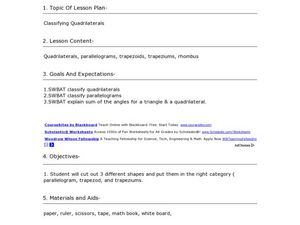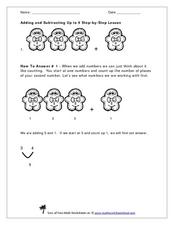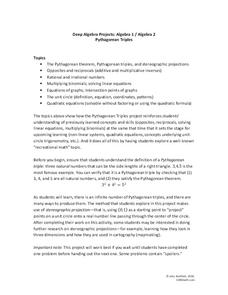Curated OER
Round and Round-The Water Cycle
Students explore the water cycle. In this earth science activity, students work in small groups to read various books on the water cycle and take notes on chart paper. Students share their notes and teach a younger audience what they...
Curated OER
What is Energy?
In this potential and kinetic energy worksheet, students will learn how potential energy and kinetic energy are used to make a roller coaster go. Then students will complete 2 short answer questions based on what they read.
Curated OER
Momentum and Conservation of Momentum
In this momentum learning exercise, students calculate momentum from the mass and velocity of an object. Students learn about the Law of Conservation of Momentum. This learning exercise has 8 matching, 6 fill in the blank, and 8 word...
Curated OER
Formulae of Ionic Compounds
For this compounds worksheet, students learn the steps to writing the formula for ionic compounds. This students work out the formula for 12 compounds.
Curated OER
Town Mouse/ Country Mouse
Students recognize the difference between the city and the country. In this City Mouse, Country Mouse lesson, students listen to a story and describe and map differences between the city and the country. Students understand that people...
Curated OER
G'Day Mate
Students understand that Australia is the smallest continent, locate it on a map and sing about the continents. In this Australia lesson, students listen to facts about Australia and complete a book about information they have learned.
Curated OER
Idioms: Elementary, Intermediate, and Advanced
In this recognizing the meanings of idioms worksheet, students match the idioms to their definitions in categories of elementary, intermediate, and advanced learning levels. Students match 27 answers.
Curated OER
Chess Lesson Plans
Students discover the game of chess. In this critical thinking lesson, students learn the rules for each chess piece and the game as a whole. Students use critical thinking, problem solving, logic, and reasoning skills to improve their...
Curated OER
This Land Is My Land
Students explore their impressions of African history, focusing on black/white relations. They examine the impact of the recent election on Zimbabwean politics by reading and discussing the article "Vote in Zimbabwe Shows Opposition...
Curated OER
Classifying Quadrilaterals
Fourth and fifth graders learn to classify quadrilaterals and use more than one name for each. They follow the directions and classify three quadrilaterals. There are also activities which can be done with a partner.
Curated OER
Adding and Subtracting Up to 5
Basic addition and subtraction need to be mastered before moving on to more challenging mathematics. This resource provides learners with one addition and one subtraction problem. They read the explanation included to learn how to solve...
Curated OER
Antonym Word Scramble
In this opposites worksheet, students learn 16 antonym pairs by unscrambling the words. There is no word bank provided for this puzzle.
Curriculum Corner
7th Grade Math "I Can" Statement Posters
Translate the Common Core math standards into a series of achievable "I can" statements with this collection of classroom displays. Offering posters for each standard, this resource is a great way to support your seventh graders as...
5280 Math
Pythagorean Triples
From Pythagorean triples to the unit circle. Learners use the Pythagorean Theorem to find Pythagorean triples and then relate their work to the unit circle in a fun algebra project. Their discovery that x^2+y^2 is always equal to one on...
Read Theory
Analogies 3 (Level 7)
Master word analogies with a straightforward exercise. Pupils match word pairs to one another based on the relationships represented in each pair. The worksheet provides bridge sentences that learners fill out as they determine the...
Flipped Math
Unit 10 Review: Quadratics
Everything one wanted to know about parabolas in one place. Pupils work 27 problems as a review of the unit on quadratics. Problems range from determining key features of the function and using that information to graph the parabola, to...
Fredonia State University of New York
Watch Your Step…You May Collide!
Can two lines intersect at more than one point? Using yarn, create two lines on the floor of the classroom to find out. Cooperative groups work through the process of solving systems of equations using task cards and three different...
EngageNY
Sequencing Translations
Investigate the results of multiple translations on an image. Scholars use vectors to perform a sequence of translations in the seventh lesson of 18. They examine the results and determine the importance of using a sequence rather than a...
Horticultural Society of New York
Dress Up Your Salad
Salad dressings use a variety of different ingredients, but it's important to have a healthy balance of greens to create a delicious mix. Young chefs examine five types of herbs including chives, basil, dill, parsley, and thyme to...
EngageNY
Solve for Unknown Angles—Angles in a Triangle
Assist your class with each angle of geometry as they use exterior angles to form linear pairs with adjacent interior angles. They cover multiple vocabulary terms and work practice problems, complete with justifications, before...
EngageNY
Angles Associated with Parallel Lines
Explore angle relationships created by parallel lines and transversals. The 13th lesson of 18 prompts scholars use transparency paper to discover angle relationships related to transversals. Learners find out that these angles pairs are...
National Research Center for Career and Technical Education
Lou-Vee-Air Car
Who said teaching a STEM lesson had to be challenging? Incorporate a career and technology-centered car build into your upcoming force lesson plan, and your class will be moving down the road in no time! Pupils practice...
Curated OER
Online ESL Quizzes- Subjects And Verbs - 1
In this online ESL subject and verbs quiz, students match the best subject and verb in 8 examples. They match the word on the left with its opposite on the right by clicking the down arrow next to the words.

























